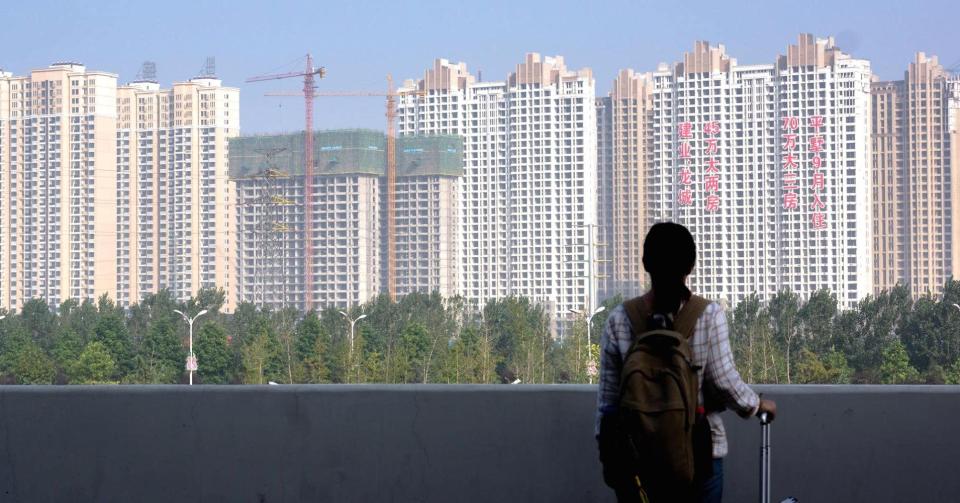China banking crisis? Here's what it might look like

It's time to keep a close eye on China's banks.
As Beijing scrambles to prop up a slowing economy and cooling real estate market, the government last week announced measures to make it easier for households and developers to borrow more money.
That may help in the short run. But the cure, say some observers, will do little to address the growing pile of bad loans that has left China 's financial system with deepening debt hangover.
"In the overall level of debt, they can still push it without creating immediate problems," said Diana Choyleva, head of Macroeconomic Research at Lombard Street Research. "But if you look at the rate of increase in debt since the global financial crisis it's extremely alarming."
China's debt has been piling up for years. To offset the financial collapse of 2008, Beijing borrowed and spent heavily on an epic building spree of roads, airports, rail lines and water projects. Now, to keep growing, China has to keep spending: More than half of gross domestic product comes from investment. (Consumer spending, while rising, makes up about a third of growth.)
Much of China's borrowing and spending fueled an historic run-up in property prices that has recently stalled, raising fears that a wider, deeper slump could weaken China's already slowing economy.
In response to slumping property prices, China last week cut mortgage rates and down payment requirements for some homebuyers for the first time since the 2008 global financial crisis. The government's latest effort to prop up a sagging real estate market also included steps to boost credit for cash-strapped developers, who risk getting stuck with too much debt if the slump deepens.
Read More World Bank trims China, East Asia growth forecasts
China's real estate market has survived similar slumps since 2008. But some economists warn the risks of a full-blown Chinese banking crisis are rising.
If it happened, the reverberations would be felt around the world, according to a report this week from economists at Oxford Economics, who ran numbers through their computer models and came up with a scenario worthy of a Hollywood disaster movie.
They figure the odds of this scenario playing out are about 10 percent, but it's not pretty. Here's what a full-blown Chinese banking collapse might look like:
The crisis begins when house prices fall 24 percent next year and another 27 percent in 2016. That unleashes a wave of bad loans as developers default, further tightening credit, driving up interest rates and forcing a bank default.
Read More China's local government debt burden varies widely: Moody's
To keep more dominoes from falling, the government floods the system with cash, financed with more debt, pushing yields on Chinese government bonds to 7 percent-despite the central bank's moves to cut short- term rates to 1.25 percent.
Despite those efforts, the damage to the Chinese economy and financial markets in this scenario would be severe.
Based on Oxford's computer models, the Shanghai stock index falls 60 percent next year and another 15 percent in 2016. Hong Kong stocks fall 12 percent next year and Singapore sells off by 9 percent.
As global investors seek shelter from the storm in U.S. Treasurys, yields would fall to 2.8 percent next year (from a predicted 3.3.percent without a China banking crisis.) The dollar soars against the Chinese Renminbi.
U.S. stocks would escape relatively unscathed in this scenario, falling 1 percent next year compared with Oxford's forecast of a 4 percent gain without a banking crisis. One reason: Oxford figures the Fed will hold off on raising rates until well into 2018-and begin its rate-supressing bond buying program again to help calm the financial waters.
Read More 'Perfect storm' to hit China economy in 2016
But the global economy would shift into even lower gear. Growth in China's GDP would fall to just 2 percent in 2015 and 1.4 percent in 2016. (Klachkin notes that China's GDP growth has never fallen below 6 percent since official record keeping began.) Emerging market economies would also be hit hard.
U.S exports would weaken, along with investment and consumer spending, slowing GDP growth to just 2 percent next year and in 2016, about a thir less than Oxford expects without a crisis.
Slower global growth would also accelerate the slump in oil prices, pulling the price of a barrel of Brent crude down to $80. Gold prices would rise 12 percent more than Oxford's current forecast. U.S. inflation would fall to 1.2 percent.
Over the past 30 years, the architects of China's modern economic development have dodged their share of economic and financial crises and kept the plan moving forward. So Oxford's disaster scenario is hardly a sure bet.
But given the high stakes if Beijing stumbles, China's ongoing transition-from a streak of red-hot, investment-fueled growth to a more sustainable, long-term path-poses major risks to the rest of the world.
"We don't think it's going to collapse," said Jonathan Schiessl, head of equities at Ashburton Investments. "We're going through this very difficult and tricky transition. And with all transitions there are always questions about how things are going to end up."

 Yahoo Finance
Yahoo Finance 
